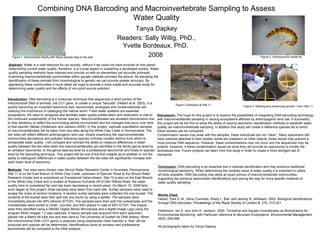
Dapkey Capstone Slide
- 1. Combining DNA Barcoding and Macroinvertebrate Sampling to Assess Water Quality Tanya Dapkey Readers: Sally Willig, PhD., Yvette Bordeaux, PhD. 2008 Abstract: Water is a vital resource for our society, without it we could not have evolved on this planet. Determining current water quality, therefore, is a crucial aspect in sustaining a developed society. Water quality sampling methods have matured and provide us with an elementary yet accurate portrayal. Examining macroinvertebrate communities within aquatic habitats provides the picture. By elevating the identification of these animals from morphological to genetic we can provide greater accuracy. By appraising these communities in such detail we hope to provide a more subtle and accurate study for determining water quality and the effects of non-point source pollution. Introduction: DNA barcoding is a molecular technique that sequences a short portion of the mitochondrial DNA of animals, the CO1 gene, to create a unique “barcode” (Hebert et al. 2003). It is quickly becoming an important taxonomic tool; taxonomists, ecologists and conservationists are realizing the importance of cataloging the natural world. Fresh water systems are essential ecosystems; the need to recognize and facilitate water quality preservation and restoration is vital to the continued sustainability of the human species. Macroinvertebrates are excellent bioindicators due to their tendency to reflect the surrounding abiotic environment and the changes that occur over time to that specific habitat (Hodkinson and Jackson 2005). In this project, replicate quantitative samples of macroinvertebrates will be taken from two sites along the White Clay Creek in Pennsylvania. The two sites will reflect different anthropogenic land use; closely examining the macroinvertebrate communities abundance and pollution tolerance species richness creates metrics from which to extrapolate water quality. I will compare and contrast the ability to measure differences in water quality between the two sites when the macroinvertebrates are identified to the family-genus level by an amateur taxonomist, to the genus-species level by a professional taxonomist and finally to species level by the barcoding technique. This project will be one of the first insights as to whether or not the ability to distinguish differences in water quality between the two sites will significantly increase with each lower level of taxonomy. Methods: Two sites were chosen near Stroud Water Research Center in Avondale, Pennsylvania. Site 11 is on the East Branch of White Clay Creek, upstream of Spencer Road at the Stroud Water Research Center and is considered an Exceptional Value stream. Site 12 is also on the East Branch of the White Clay Creek and is located at Rosazza Orchards off of Glen Willow Road, the water quality here is considered fair and has been decreasing in recent years. On March 10, 2008 field- work began on this project; three samples were taken from each site. Surber samplers were used to scrape the rocks at random locations; 4 random surber samples were collected into one bucket. The contents of the bucket were then split into one fourth by using a splitter. The samples were immediately placed into 95% ethanol (ETOH). The samples were then split into subsamples and the invertebrates were sorted to Order, counted, and then placed in vials of 95% ETOH. The insects were then identified using a DM39Z Digital Stereo Microscope and a digital image (.jpg) using the program Motic Images 1.2 was captured. A tissue sample was acquired from each specimen, placed into a Matrix 94 tube box and then sent to The University of Guelph for DNA testing. When the mitochondrial DNA (CO1 gene) is analyzed using polymerase chain reaction a “tree” will be produced and species will be determined. Identifications done by amateur and professional taxonomists will be compared to the DNA analysis. Discussion: The hope for this project is to explore the possibilities of integrating DNA barcoding technology with macroinvertebrate sampling in varying ecosystems affected by anthropogenic land use. If successful, this project will be the first to show the ability of varying taxonomic identification methods to establish water quality via macroinvertebrate sampling. In addition this study will create a reference species list to which future studies can be compared. Contamination issues may arise with the samples, these individuals are not “clean.” Many specimens still have particles attached to their bodies, some are predators on other insects; these issues may prevent a more precise DNA sequence. However, these contaminations may not occur and the sequences may be pristine. However, if these contamination issues do arise they will provide an opportunity to modify the techniques now. Future projects can learn from this study in order to create a more stringent set of standards. Conclusion: DNA barcoding is an essential tool in species identification and may enhance traditional morphological taxonomy. When determining the complex issue of water quality it is important to utilize all tools available. DNA barcoding may allow an exact picture of macroinvertebrate communities, supporting the previous taxonomists identifications and paving the way for more specific methods of water quality sampling. Works Cited: Hebert, Paul D. N., Alina Cywinska, Shelly L. Ball, and Jeremy R. deWaard. 2003. Biological identifications through DNA barcodes. Proceedings of the Royal Society of London B. 270, 313-321. Hodkinson, Ian D. and John K. Jackson. 2005. Terrestrial and Aquatic Invertebrates as Bioindicators for Environmental Monitoring, with Particular reference to Mountain Ecosystems. Environmental Management. 35(5), 649-666. All photographs taken by Tanya Dapkey Figure 1. Ephemerellid Mayfly with tissue sample (leg) to the side Figure 2. Hydropsychid caddis fly Figure 3.Sampling at Site 11 Figure 4. Splitting and preserving sample 1 from Site 11